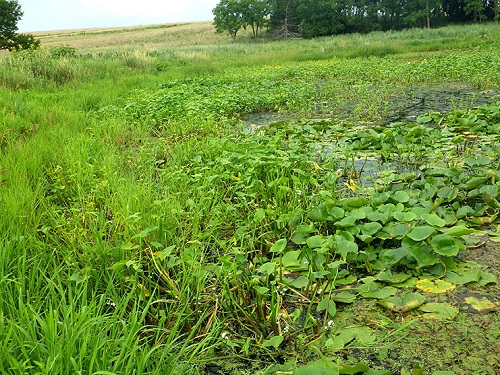The Iowa Department of Transportation recently detailed in a blog post the “balancing act” required in order to minimize the impact of road and bridge construction projects on the environment.
[Above photo by the Iowa DOT]
That “balancing act” can also result in environmental revitalization as well, the agency stressed, such as for wetland areas that improves wildlife viewing, hunting, and other outdoor activities.
“By law, we are required to avoid and minimize impacts to water resources if we can. If that’s not possible, we will work to mitigate any impacts, often going above and beyond what is required if there is a cost-effective way to get that done,” explained Brandon Walls, a project manager in the water resources section of the Iowa DOT’s Location and Environment Bureau.
“In a nutshell, it means we can’t avoid impacts to water resources in the construction area, so we make up for the damage to the wetlands or streams in the construction area somewhere else,” he said.
Walls pointed to an Iowa DOT-constructed wetland mitigation site near Steamboat Rock in Hardin County as an example of the agency’s mitigation efforts. That site, called Hoover Ruby Wildlife Area, is owned by the Hardin County Conservation Board and was constructed to offset wetland impacts associated with two U.S. 69 Bridge replacement projects in Wright and Hancock counties.
“Because the impacted areas contained both emergent and forested wetlands, we [Iowa DOT] were responsible for re-creating those types of wetlands in this area owned by Hardin County,” he noted.
“We also work with the Army Corps of Engineers on mitigation sites to ensure we are developing enough wetland areas of a certain quality to meet the permit requirements,” Walls pointed out. “This specific permit required us to build 1.76 acres of emergent wetland and 0.4 acres of forested wetland, but we thought it was necessary to go beyond those baseline requirements to provide an area that would be more useful.”
He said that a successful forested wetland can be particularly challenging to reconstruct. Although the emergent wetland at Steamboat Rock is thriving, the trees originally planted in the forested wetland portion didn’t survive after they were planted, so Walls and his team engaged in a second round of seedling planting.
[Editor’s note: The Wyoming Department of Transportation is engaged in a similar wetlands restoration effort as part of its Snake River channel project.]
“We’re trying to keep as much of this work in-house to replant the forested wetland so we can to keep the costs down,” he explained. “We worked with the State Forest Nursery to get seedlings, which cost less than $300. I asked for volunteers from our bureau to help me plant the seedlings. Nine of us planted 225 trees of four species that like to have their feet wet.”
In another cost-saving measure, Walls and the team recycled tree tubes used to support the young saplings and protect them from being eaten by deer. “The saplings are very small and hard to see,” he added. “We went out and collected protective tubes from another wetland mitigation site that had grown up enough to not need them anymore.”
Walls will be responsible for monitoring this site for the next few years to make sure it succeeds and grows into a successful wetland area. “I have trail cameras out there and one of the coolest things I’ve seen is a pair of Sand Hill Cranes,” he said. “They haven’t been spotted much in Hardin County, so seeing them use our site is exciting.”
Once the entire wetland is functioning as it should, the Hardin County Conservation Board will take over the monitoring and maintenance long-term. “This is going to be a really nice resource for the public to hunt and view wildlife,” Walls noted.
